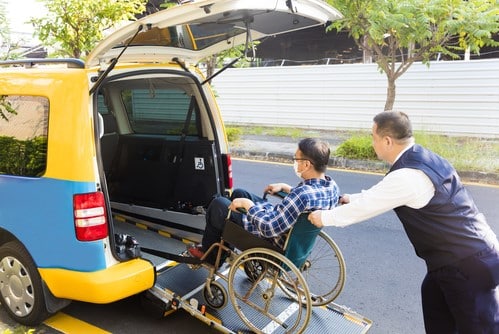Wheelchair taxi options unfortunately aren’t as widespread as they should be given the number of people who would benefit from them. In Australia, more than 4.4 million people live with a disability. Of them, nearly 5% use a wheelchair. That’s 220,000 people who don’t have the same easy access to a cab as anyone else.
Not only is this unfair, but on the part of big taxi companies it seems to be quite the oversight. They’re losing income from a significant and important segment of society – Australians who have every right to be able to access the transport they require to get to places as and when they need to.
In this article, we’ll not only highlight what’s missing with wheelchair taxi options. We’ve also compiled a list of accessible taxi options available in Australia.
We need more wheelchair taxi options in Australia
International companies like Uber and Lyft have been in operation since 2009 and 2012 respectively, yet both only have wheelchair taxi options available in Canada and the US. And even in the U.S, it seems wheelchair users aren’t always being treated fairly.
A 2015 article on Wired says Uber’s business isn’t built to help disabled people. And in 2017, the New York Times wrote that Uber faced a class-action lawsuit filed by Disability Rights Advocates. Because while it does offer wheelchair accessible taxis (WAT) options in the US, there are too few of these cars and they’re seldom available. That said Uber has trialed wheelchair accessible transport in Brisbane.
And to make things worse, the WATs in the fleet can accept jobs booked by people without a disability. So, when someone with a wheelchair tries to book a WAT, they may already be off carrying someone who doesn’t need it.
In 2015, Uber trialled its first WATs in Australia, but to date we haven’t seen it launched. Uber Assist is available here though, whereby drivers are trained to help customers with a disability.
But they can only accommodate assistive devices that fold and can be stored in the trunk. Which for many wheelchair users just isn’t workable.
Disability Transport Standards for Accessible Public Transport
The Australian government introduced the Disability Standards for Accessible Public Transport 2002 a couple of decades ago with a mid to long term view. Many of these standards have already been implemented by our bus transport system, with the progress aimed to be complete by 2022 (buses) and 2032 (trams).
We’d love to know what you think about the current state of accessible public transport – remember to share your comments at the end of this article.
We’re aware that using public transport can be tricky as it means planning in advance and working to a timetable. And even that can go out the window when the public transport vehicle misses a stop, is too full to take new passengers or is behind schedule. Which is why it’s good to have a list of different transport options at hand, and access to taxis when you need to get somewhere on time.
So, we’ve made a list of wheelchair taxi operators:
We’re aware that using public transport can be tricky as it means planning in advance and working to a timetable. Which is why it’s good to have a list of different transport options at hand.
So, you can get where you need to when you need to. Which is why we’ve made a list of wheelchair taxi operators:
Wheelchair taxis in Australia
While not all taxi companies are keeping pace with the offering of WATs, there are some who have been. Though, arguably, they too could do with adding more to their fleets.
Here’s our (non-exhaustive) list of some wheelchair taxi options in Australia:
- 13 Cabs Australia wide
- 13 Maxi Cabs Sydney
- Black and White Cabs Melbourne, Perth
- Zero 200 Sydney
- Silver Top Melbourne
- RSL Sydney
Did you know you might be able to get discounted fares? Read about taxi subsidies for wheelchair and mobility scooter users.
Wheelchair taxi requirements
The afore-mentioned disability standards have a checklist of requirements every wheelchair taxi must adhere to.
For example, they require a WAT to have a four-point restraint system for wheelchairs. Hoists need to be firmly mounted to the WAT and have a skid resistant surface, approach edges and an outer roll stop. If a WAT has ramps, they need to be a minimum of 800mm wide, and the slope mustn’t be steeper than one in six.
Security and safety are key for both passenger and driver.
Owning a WAV or disability converted car
If you own a WAV or disability converted car, we understand the immense value it provides in getting you from A to B. And doing so according to your schedule rather than someone else’s! Which is why our WAV and converted car insurance premiums won’t cost you more like they do with many general insurance providers.
Our disability car insurance is your assurance that if your WAV or converted car is damaged or stolen we help pay the cost of repair or replacement up to the agreed value. Plus we cover any assistive technology in the vehicle that’s damaged during an accident, up to $5,000.
We also offer wheelchair insurance, which helps cover your financial losses for damage or theft of your chair – wherever you are. So you can keep you moving toward your destination and goals.








